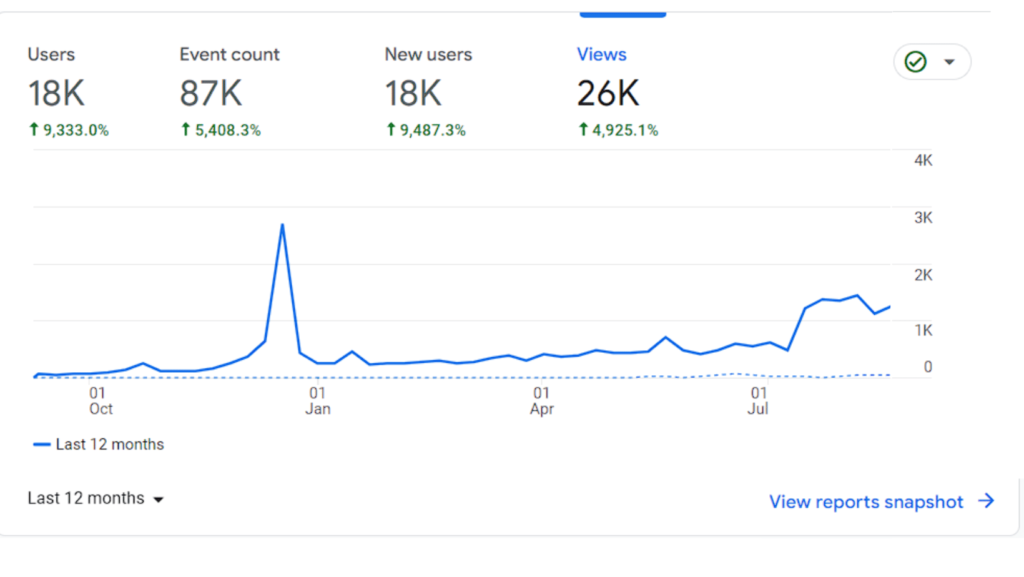Welcome back to our ever-evolving journey through the vast landscape of the digital realm. In this week’s installment of the Digital Mastery Series, we’re about to embark on an exciting expedition into the world of SEO, and more specifically, the art of conducting search analysis.
Now, you might be wondering, “What’s all the buzz about search analysis, and why should I care?” Well, my friends, it’s time to buckle up because we’re about to unveil the secrets that can take your online presence to new heights. If you’ve ever wondered how to make your digital content shine like a beacon in the crowded expanse of the internet, you’re in the right place!
Search Analysis, as we’re about to discover, is the compass that guides your content through the vast sea of the internet, ensuring it reaches the right shores—your target audience. It’s the key to unlocking the secrets of SEO, helping you understand what your audience is searching for, how your competitors are positioning themselves, and ultimately, how to craft content that not only ranks high but resonates deeply with your readers.
So, whether you’re a seasoned digital marketer, a budding blogger, or an entrepreneur looking to boost your online presence, this journey through the realms of search analysis is bound to equip you with the knowledge and tools you need to thrive in the digital age.
The Basics of Search Analysis
Welcome to the very foundation of our journey into the world of search analysis. In this section, we’re going to start with the basics—what search analysis is and why it’s crucial in the realm of SEO.

Understanding Search Analysis
Imagine you’re embarking on a treasure hunt, and the treasure is, in this case, a steady flow of website visitors and increased visibility for your online content. The map to this treasure is search analysis.
Search analysis is the process of examining and understanding the way people search for information online. It involves the systematic study of search queries, keywords, and the intent behind those searches. It’s essentially deciphering the language of your audience and understanding their digital footprints.
Why Does Search Analysis Matter?
Search analysis matters for several key reasons:
1. Improved Visibility
By understanding how people search, you can optimise your content to align with those search patterns. This means your content is more likely to show up in search engine results when people look for information related to your niche.
2. Targeted Content
Search analysis helps you create content that directly addresses the needs and questions of your audience. It’s like a tailor-made suit that fits perfectly—your content is crafted to meet the exact requirements of your audience.
3. Competitive Edge
It’s not just about your audience. Search analysis allows you to keep an eye on your competitors, too. You can uncover the keywords they’re ranking for and gain insights into their strategies, which can inform your own approach.
4. Better User Experience
When you know how your audience searches, you can create a more user-friendly experience. Your content becomes easier to find, and visitors are more likely to stay engaged.
The Power of Keywords
Keywords are at the heart of search analysis. These are the words and phrases that people type into search engines like Google when seeking information. Effective search analysis involves identifying and prioritising the right keywords for your content.
The goal is to use keywords strategically, ensuring they are relevant to your content and match the intent of the searcher. This alignment is what can catapult your content to the top of search results.
In this first section of our journey into search analysis, we’ve laid the groundwork for understanding its significance. Search analysis is the bridge that connects your content to your target audience. It helps you speak the language of your readers and ensures your digital presence is well-optimised.
Tools of the Trade
In our journey toward mastering the art of search analysis, we’ve reached a pivotal section: “Tools of the Trade.” Understanding the fundamentals is crucial, but having the right tools at your disposal can make all the difference in your quest for SEO excellence.

The Digital Arsenal
Just as a carpenter needs quality tools to craft a masterpiece, a digital marketer or SEO enthusiast needs a set of trusty instruments to navigate the vast landscape of search analysis. Let’s explore the essential tools that will empower you on this quest:
1. Keyword Research Tools
- Google Keyword Planner: A free tool by Google that provides insights into keyword search volumes and competition.
- Ahrefs: A comprehensive SEO toolset that includes powerful keyword research features.
- SEMrush: Offers a suite of SEO tools, including a robust keyword research tool.
2. Competitive Analysis Tools
- SEMrush: Besides keyword research, SEMrush also provides in-depth competitor analysis.
- SpyFu: A tool designed for competitive intelligence, helping you uncover your competitors’ keywords and ad campaigns.
- Moz Pro: Offers competitor analysis and other SEO-related features.
3. Analytics Platforms
- Google Analytics: Provides valuable insights into the performance of your website and content.
- Google Search Console: Helps you monitor and optimise your site’s presence in Google search results.
- Bing Webmaster Tools: Similar to Google Search Console but for Bing search results.
4. Content Management Systems (CMS)
- WordPress: A popular CMS with SEO-friendly plugins like Yoast SEO.
- Joomla: Offers SEO extensions and features to improve your site’s SEO.
- Drupal: Known for its flexibility and SEO optimisation options.
5. Browser Extensions
- MozBar: A browser extension by Moz that provides on-the-spot SEO metrics while you browse the web.
- Keywords Everywhere: Shows search volume, CPC, and competition data for keywords in various search engines.
The Power of Research
These tools are your digital companions on your search analysis journey, helping you uncover valuable insights, track progress, and make informed decisions. Whether you’re diving into keyword research, analysing competitors, or monitoring the performance of your content, having the right tools at your disposal can save you time and offer a competitive advantage.
Embracing Tools for Success
In this section, we’ve unveiled the digital arsenal you need to succeed in the world of search analysis. These tools are your allies in deciphering the language of your audience and optimising your online presence for maximum visibility.
Now that you’re equipped with the essentials, in the next section, we’ll roll up our sleeves and dive into the art of keyword research. We’ll uncover the secrets of finding the right keywords to boost your content’s visibility and reach the right audience. So, stay tuned, as we delve deeper into the heart of search analysis and SEO mastery!
The Art of Keyword Research
In this section, we’re delving deep into the art of keyword research, where the magic of SEO begins. Choosing the right keywords is like selecting the colours for your digital masterpiece, and understanding the key elements of keyword selection is crucial.

The Elements of Keyword Selection
When it comes to selecting the perfect keywords for your content, several key elements come into play. Here’s how you can master this intricate process:
1. Search Volume
- Finding It: Tools like Google Keyword Planner, Google Trends, Ahrefs, and SEMrush can provide data on search volume for specific keywords.
- Significance: High search volume indicates popular keywords, but competition can be fierce. Balance this with your site’s authority. The holy grail of search analysis is finding a keyword with both high search volume and low competition. It must be mentioned that these cases are often rare to find – but are gold if you can find them. Often niche interests, location specific and long-tail keyword queries are where these can be found.
2. Keyword Competition
- Finding It: As mentioned earlier, SEO tools like Ahrefs and SEMrush offer insights into keyword competition.
- Consideration: Low-competition keywords can be your entry point into SEO success, but ensure they align with your content. If you find a low competition keyword – fill the gap with a high-quality piece of content – your chances of reaching the top are enhanced greatly.
3. User Intent
- Understanding It: Analyse the reason behind the search. Is the intent informational, navigational, or transactional?
- Crafting Content: Tailor your content to match the user’s intent.
4. Long-Tail Keywords
- Discovering Them: Tools can help, but long-tail keywords often arise naturally during brainstorming. A great method is to start a typing a search term into google. Google will then provide suggested search queries based upon what other people have been searching. These queries can offer you inspiration for your keyword research and content creation.
- Value: These less competitive, more specific phrases can be your secret weapon.
5. Competitor Analysis
- Finding Competing Content: You can use SEO tools to see what keywords your competitors are targeting.
- Evaluating Competing Content: When checking the competition, consider the authority of the sites ranking. Are they authoritative sources? Is the content ranking at the top high-quality, or is it thin and of poor quality? If the quality and authority are low – this is a great gap to fill with high-quality content that serves the user.
The Keyword Strategy
Once you’ve gathered your keywords, it’s time to create a keyword strategy that incorporates these key elements:
1. Prioritise Keywords
- Focus on keywords with a balance of decent search volume and manageable competition.
- Keep your specific audience in mind.
2. Diversify Your Keywords
- Include a mix of short-tail and long-tail keywords to capture a broad audience.
- Align them with your content’s purpose and user intent.
3. Content Optimisation
- As we’ll explore in later chapters, ensure your chosen keywords naturally integrate into your content.
- Craft content that not only includes keywords but offers value to your audience.
Competitive Analysis – The Road to SEO Victory
In this chapter, we’re stepping into the realm of competitive analysis, a powerful tool on your journey to SEO victory. Just like explorers study maps to navigate uncharted territories, you’re going to delve into your competitors’ strategies to gain an edge in the digital landscape.

The Competitive Advantage
Competitive analysis isn’t about mimicking your rivals; it’s about understanding their tactics, recognising opportunities, and creating a unique path to success. Here’s how you can harness the power of competitive analysis:
1. Identify Your Competitors
- Finding Competitors: Start by pinpointing your online competitors. These are the websites and businesses targeting the same audience as you.
- Using SEO Tools: SEO tools like SEMrush and Ahrefs can help you discover who your digital rivals are.
2. Analyse Their Keywords
- Tools at Your Disposal: As previously mentioned, SEO tools are invaluable. Use them to explore the keywords your competitors are targeting.
- Question the Competition: Consider the quality of your competitors’ content and the keywords they’re using. Are they authoritative sources? Is their content top-notch or thin?
3. Content Evaluation
- Quality Check: Examine your competitors’ content. Is it comprehensive, engaging, and informative?
- Assess User Experience: How user-friendly is their website? Is it easy to navigate and visually appealing?
4. Backlink Analysis
- Tools for Insight: Tools like Ahrefs and Moz can provide insights into your competitors’ backlink profiles.
- Link Building Inspiration: By studying their backlinks, you might discover opportunities for your own link-building strategies.
5. Social Media Presence
- Social Listening: Observe your competitors’ social media activity. What platforms are they on, and how are they engaging with their audience?
- Content Promotion: Learn from their social media successes and strategies for promoting content.
6. Content Gap Analysis
- Finding Opportunities: Identify areas where your competitors may be lacking in content or user experience.
- Closing the Gap: Use this information to create content that outperforms what’s currently available.
A Path to Success
Competitive analysis is your guide through the often complex and challenging terrain of SEO. It helps you see what’s already been done, what works, and where opportunities lie.
By understanding your competitors’ strategies, you’re better equipped to refine your own approach, crafting content and optimising your site in a way that sets you apart.
Search Analysis – What Next?
In this chapter, we’ve unraveled the secrets of competitive analysis—a crucial step in your SEO journey. Your competitors are like fellow travelers on the same road, but it’s your unique strategies that will lead you to success.
As we continue our expedition through the world of search analysis, stay with us as we explore the exciting world of content optimisation. It’s where your keyword research and competitive analysis come together to create content that truly stands out in the digital wilderness. So, let’s forge ahead and continue our quest for digital mastery!
Content Optimisation – Crafting Your Digital Masterpiece
In this section, we’re diving deep into content optimisation, where you’ll learn the art of harmoniously weaving keywords into your content and ensuring it’s not only search engine-friendly but also captivating for your human audience. Just as a skilled chef combines the right ingredients for a delectable dish, you’ll blend keywords into your content for a flavorful SEO recipe.

The Art of Keyword Integration
When it comes to optimising your content, keyword integration is key. It’s not just about sprinkling keywords randomly; it’s about strategic placement for maximum impact. Here’s how to do it effectively:
1. Titles and Headlines
- Best Practices: Craft compelling and descriptive titles that include your target keyword. This helps both users and search engines understand the topic.
- Keyword Placement: Place your primary keyword at or near the beginning of the title.
2. Subheadings (H2, H3, etc.)
- Structural Significance: Subheadings break up your content, making it more readable.
- Keyword Placement: Use secondary and related keywords in your subheadings, if they naturally fit.
3. Content Body
- Keyword Density: Avoid keyword stuffing; aim for a natural keyword density of around 1-2%.
- Keyword Variation: Use variations of your target keyword to keep the content natural and engaging.
4. Meta Descriptions
- Compelling Summaries: Craft meta descriptions that include your keyword and encourage click-throughs from search results.
- User Engagement: Focus on making the meta description informative and enticing to users.
Guiding Your Content Strategy
Your keyword research should serve as the compass guiding your content strategy. It ensures you have the search volume (the traffic) and a high chance of ranking on the first page (low competition). Here’s how to do it:
1. Choose the Right Keywords
- Relevance: Select keywords that directly relate to your content’s subject matter.
- Strategic Planning: Prioritise keywords that align with your content and have manageable competition.
2. Content Planning
- Content Structure: Create an outline for your content that includes main points, subtopics, and where keywords will fit naturally. Use your keyword research to develop your content. Do not create content that is aimless and not targeted user intent.
- User Intent: Keep user intent in mind; ensure your content addresses their needs.
3. Keyword Mapping
- Strategic Placement: Map out where your primary and secondary keywords will be used in the content.
- Balanced Distribution: Ensure keywords are spread out evenly rather than concentrated in one section.
Next Steps – Tracking Your Success
In this section, we’ve unveiled the intricacies of content optimisation, including the best practices for integrating keywords into your titles, subheadings, and content. Remember, your keyword research isn’t just a preliminary step; it’s your content’s strategic foundation. It ensures you’re not only attracting traffic but also positioned to rank prominently.
As we continue our exploration of the world of search analysis, stay tuned for the next section, where we’ll unravel the mysteries of measuring success. We’ll delve into the essential role of analytics in tracking your progress and ensuring your SEO efforts are yielding fruitful results. So, keep the enthusiasm alive as we press on in our quest for digital mastery!
Measuring Success – Navigating Your SEO Journey
In this section, we’re delving into the world of measuring success, an essential aspect of your SEO journey. Just as explorers use maps and compasses to ensure they’re on the right path, you’ll rely on analytics to track your progress and make informed decisions. Let’s navigate the seas of data and chart your course for SEO excellence.

The Significance of Measuring Success
Measuring success in the world of SEO is like taking stock of your journey. It tells you where you’ve been, where you’re headed, and if you’re on the right track. Here’s how you can ensure your SEO efforts are on point:
1. Key Performance Indicators (KPIs)
- Defining Success: Start by setting clear KPIs. What do you want to achieve with your SEO efforts?
- Common KPIs: These can include organic traffic, click-through rate (CTR), keyword rankings, and conversion rates.
2. Website Analytics Tools
- Google Analytics: This powerful tool provides insights into website traffic, user behavior, and more.
- Google Search Console: Focuses on your site’s presence in Google’s search results and helps identify issues.
3. Regular Monitoring
- Consistency is Key: Regularly monitor your KPIs to spot trends and identify areas that need improvement.
- Adjust Strategies: Use your findings to adjust your SEO strategies and content creation based upon the content that is performing well. You will often find the Pareto principle takes effect with your content – were 80% of your traffic comes from 20% of your content.
The Path to SEO Excellence
The road to SEO excellence is not a one-time journey. It’s an ongoing process that involves constant analysis and refinement.
1. Keyword Performance
- Rankings: Check how your targeted keywords are performing in search results.
- Keyword Expansion: Explore new keyword opportunities based on user trends and search volume.
2. Content Evaluation
- Engagement Metrics: Assess user engagement with your content, such as bounce rate, time on page, and social shares.
- Quality Assessment: Continuously improve your content’s quality and relevance.
3. Backlink Analysis
- Backlink Growth: Monitor the acquisition of high-quality backlinks to boost your site’s authority.
- Link Removal: Identify and disavow toxic or spammy backlinks that could harm your site.
Search Analysis – Staying on Track
In this chapter, we’ve embarked on the journey of measuring success, a critical aspect of your SEO efforts. Just as a navigator relies on instruments to ensure they stay on course, you’ll use analytics to stay on the path to SEO excellence.
Avoiding Common SEO Pitfalls – Navigating with Care
In our final chapter, we’re taking a closer look at the common SEO pitfalls that can derail your journey to digital mastery.

The Road Less Traveled
In the world of SEO, it’s all too easy to make missteps that can impact your efforts negatively. Let’s explore some of the most common SEO pitfalls and how to avoid them:
1. Keyword Stuffing
- The Pitfall: Overloading your content with keywords in an attempt to manipulate search engine rankings.
- The Solution: Write for your audience, not for search engines. Use keywords naturally and in context.
2. Neglecting Mobile Optimisation
- The Pitfall: Ignoring the growing importance of mobile-friendliness.
- The Solution: Ensure your website is responsive and optimised for mobile devices. Test it on various screens. Opt for mobile first design – you can learn more about this with my guide.
3. Ignoring User Experience
- The Pitfall: Focusing solely on keywords and rankings without considering user experience.
- The Solution: Create a user-friendly website with easy navigation and fast load times. You can learn more about creating a user friendly website with my guide. You can also learn all about navigation and the various menus that you should implement on your website with my other guide.
4. Inadequate Content Quality
- The Pitfall: Publishing low-quality or irrelevant content.
- The Solution: Prioritise content that adds value to your audience and aligns with your keyword strategy. Avoid thin content that does not answer the users search query, comes across as spammy or is low value to the user.
5. Neglecting Analytics
- The Pitfall: Failing to monitor and analyse your SEO performance.
- The Solution: Regularly review analytics to spot trends, make data-driven decisions, and adjust your strategies accordingly.
6. Impatience
- The Pitfall: Expecting immediate results from your SEO efforts and failing to understand the concept of Google’s sandbox, where new websites may experience a delay in ranking.
- The Solution: Understand that SEO is a long-term strategy; it takes time to see significant improvements. Be patient and continue to improve your site’s quality. Do not be discouraged as significant results can take anywhere from 6 to 12 months of publishing high quality content.
The SEO Blueprint
Avoiding these common pitfalls is like following a well-drawn map. It’s essential for a smooth SEO journey. By crafting high-quality content, optimising for mobile, providing an excellent user experience, and keeping an eye on analytics, you’ll steer clear of the hazards that can hinder your progress.
The Ongoing Journey of SEO Mastery
As we reach the final section of this Digital Mastery Installment, it’s crucial to emphasise that SEO is an ongoing journey. Just as the best explorers keep pushing the boundaries of the known world, you should continually seek to refine and expand your SEO skills.
Embracing Ongoing Learning
SEO is not a static field; it’s a dynamic, ever-evolving landscape. To achieve and maintain digital mastery, it’s essential to commit to lifelong learning. Here are some key aspects to keep in mind on this journey:
1. Algorithm Updates
Search engines like Google regularly update their algorithms. Stay informed about these changes and adjust your strategies accordingly.
2. Trends and Emerging Technologies
Stay up-to-date with the latest digital marketing trends and emerging technologies. Voice search, AI, and mobile optimixation are just a few areas to watch.
3. Regular Audits
Periodically audit your website’s SEO to identify areas for improvement. This includes checking for broken links, updating content, and ensuring mobile-friendliness.
4. Community Engagement
Engage with the SEO and digital marketing community. Online forums, conferences, and webinars are excellent sources of knowledge and networking.
5. Content Evolution
Continue to refine your content creation skills. Explore new content formats, experiment with multimedia, and fine-tune your storytelling.
A Journey Worth Taking
The journey of SEO mastery is a path filled with discovery, challenges, and rewards. It’s not about reaching a destination but about continuously evolving and adapting to the digital landscape. The pursuit of excellence in SEO is a journey worth taking.
Conclusion
Your journey through this Digital Mastery Installment has equipped you to leave a lasting digital legacy. Your digital footprint will impact how people discover and engage with your content, products, or services. By mastering the art of SEO, you have the power to shape your online presence and connect with your target audience effectively.
Your Journey Continues
As you conclude this series, remember that your journey in the digital world is far from over. SEO is an ever-evolving field, and the strategies and tactics you’ve learned here are just the beginning. Continue to explore, learn, adapt, and stay curious about the digital landscape. With ongoing dedication and a commitment to excellence, your path to digital mastery will be one of continuous growth and achievement.
Thank You for Joining Us
I extend my heartfelt thanks for joining me on this journey. Your enthusiasm and commitment to digital excellence are the driving forces behind your success. Keep exploring, keep optimising, and keep reaching for digital mastery. Wishing you the very best in your digital endeavors, and may your path be filled with continued success and learning!
Further Reading: Explore More Digital Mastery Articles
Crafting a Compelling About Us Page
Learn how to create an About Us page that tells your brand’s story, builds trust with your audience, and sets the tone for your online presence. Dive into the art of crafting compelling narratives that resonate with your visitors.
Website Design and User Experience
Explore the critical aspects of website design that enhance the user experience. From intuitive navigation to visually appealing layouts, this article provides insights into creating websites that engage and captivate your audience.
Responsive Web Design: Ensuring Mobile Compatibility
Discover the world of responsive web design and its importance in today’s mobile-driven landscape. Learn how to ensure your website is mobile-friendly, providing a seamless experience for users on various devices.
These articles are part of my ongoing Digital Mastery Series, designed to equip you with the knowledge and skills to excel in the digital realm. Stay connected with me as we continue to delve into the ever-evolving world of digital marketing and SEO.















